The Creation of a French Banknote
It is quite a project to create finished banknotes, ready for distribution. I have laid out the general steps involved, from artist's sketches through to finished product, with examples (where I have them!) at various stages of the process.
Artist's Sketches
The first concepts of a banknote's design come from sketches that an artist will make. These sketches are found from very rough to quite complete banknotes, and are usually single-color pen and ink drawings, maybe just of a certain area of a banknote.
Artist's Project (Maquette)
Many more "project" drawings and prints are made, than make it through to the final accepted banknote designs. These projects can be in the form of pen and ink drawings, watercolors, or more final prints. For banknotes that were actually issued, the artist's drawings are usually kept by the bank, so most drawings in collector's hands are of unreleased designs. They are all rare.
Engraving and Printing
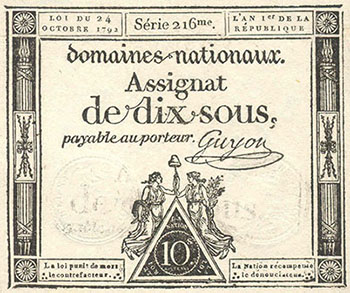
Once the art has been approved, one or more engravers is assigned the task of creating the printing plates. One for each color, engraved typically in either boxwood or mild steel before the advent of computerized and photograpically generated plates.
Single Color Relief Printing
The early assignats of the 18th century and the first Banque de France notes from 1800 to 1862 were printed with relief printing, also known as typography. This is done by cutting the background of the design into a wood or stone block or plate, leaving the desired printing elements proud of the surface. Ink can then be rolled onto the raised surfaces, and the plate pressed into the watermarked paper. At this time, banknotes were printed on the face only, using black ink.
The Blues
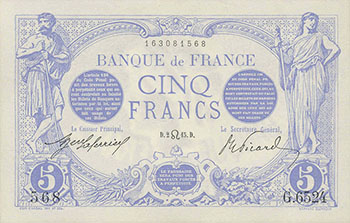
In 1862 with the advent of photography and security concerns of photographic copies of banknotes, Banque de France began printing on both sides of notes in changed to blue ink which was harder to reproduce than black. The first blue banknote was the 1000F Bleu, type 1862.
Bistre or Rose?
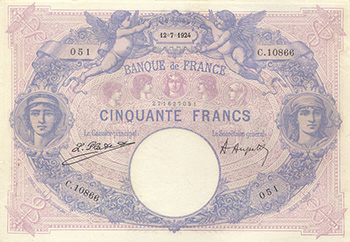
In 1873, it was decided that a second color needed to be added to banknotes, to further protect from photographic reproduction. The 20F blue and bistre note was printed, but was not released into circulation because of the ellimination of the 20F denomination. By the time the next series of notes were to be printed, BdF had decided that a rose color, rather than bistre, would be harder to photograph, and the 500F Bleu et rose type of 1888 would be the first bi-colored note issued into circulation.
Multicolor






In 1906 Banque de France produced the first multicolor French note, the 100F Luc-Olivier Merson, requiring four color plates. Still using relief printing, this added the technical challenge of registering (aligning) the print passes across the colors.
Intaglio
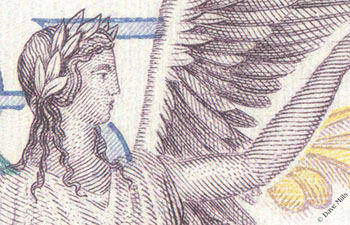
After 1939 a single color intaglio print was often applied over the multicolor relief print, to again improve security by adding fine details to the image. This intaglio was usually only done on the face side of the note. Intaglio printing is a security mechanism which is very expensive to reproduce. Visually, the main subject can be made to stand out from the rest of the design, and "jump off the paper". With intaglio printing, the artwork is engraved into a plate of steel. Ink is applied to the plate, then the surface wiped clean, leaving ink only in the recessed areas. Paper is pressed against the plate under high pressure, causing the ink to transfer onto the paper. Intaglio printing creates a very fine set of lines, as well as embossing of the paper due to the pressure of forcing the paper into the plate. It is generally used only for the finest printed products (e.g. an "engraved invitation"). The first French note to receive this treatment was the 5000F Victoire issue.
Offset Lithography
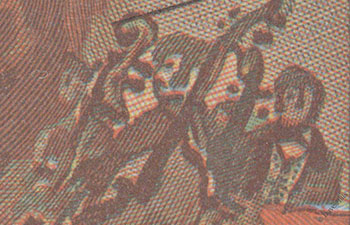
Since 1972, French banknotes have been printed via offset lithographic process rather than relief. In the lithographic process, the design is applied to a flat plate using materials that have differing surface tension properties. These properties have the characteristic of attracting or repelling the applied ink, which then can be pressed onto the paper. Offset lithography adds a rubber roller to the mechanism, which picks up the ink by rolling across the plate, then rolls the ink onto paper.
Artwork Reuse

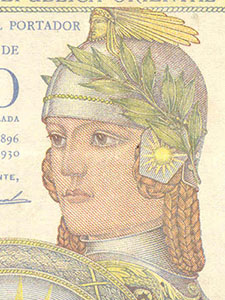
It is not uncommon to find that artwork created for one note was reused on another note. On the left, we have Uruguay P-17, the Centennial issue designed by Clement Serveau. The figure of Minerva was later reused by Sebastien Laurent for the French Indochina P-56 note.
Watermark
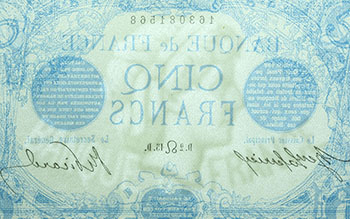
Banque de France has always required watermarks in its paper, as a security technique. These watermarks are implemented during the paper manufacturing process, and are made by varying the thickness of the paper. Early watermarks were only areas of thin paper, made by modifying the mold of the paper, and created light watermark areas. Later in the 19th century, dark watermarks were also used, and finally in 1862 the 100F Blue note was released with a more complex shaded watermark. All three of these watermark styles can be in use at the same time, and in fact the 5f Blue Type 1905 shown here has "BANQUE" as a light watermark, "FRANCE" is dark, and the bust is shaded.
Printer's Waste
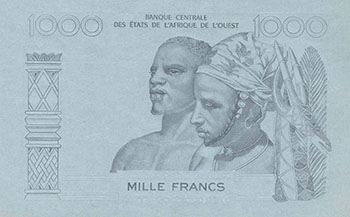
During the printing process, all waste and errors are intended to be destroyed. Some such material inevitably escapes the facility and ends up on the open market. I would include in this category test prints (often called "printer's proofs" if you're selling them) on cheap colored non-watermarked paper, which are simply done to check the print quality before using the final watermarked paper to produce the banknotes.
Proofs
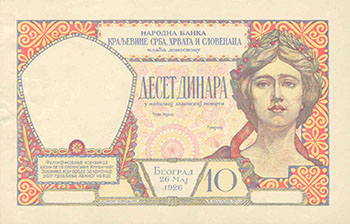
Proof notes, either during the printing process or as Artist's Proofs, are found in either the final or other trial colors. They may be uniface (printed only on one side), on either watermarked or unwatermarked paper. Fewer Proof notes are made than Specimen notes, so they are quite rare.
Specimens
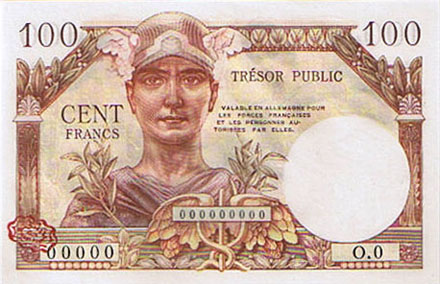
Specimen banknotes were issued to provide foreign and regional banks with sample copies of banknotes, either as notification of a banknote's release, or to help determine forgeries. The earliest Specimen notes were existing notes overprinted with "Annule" stamp. Later notes were printed specifically as specimens, with "0000" serial numbers (sometimes hand-written), or the word "SPECIMEN" perforated or printed in the paper. Typically at most 300 Specimen copies are made of any banknote, so they are rare.
Errors
Inevitably, errors will work their way through the printing facility and be released into circulation. Dramatic errors, such as missing printing passes, uniface printings and folded paper can be quite rare and valuable. Other minor errors such as color mis-registration tend to be quite common.
